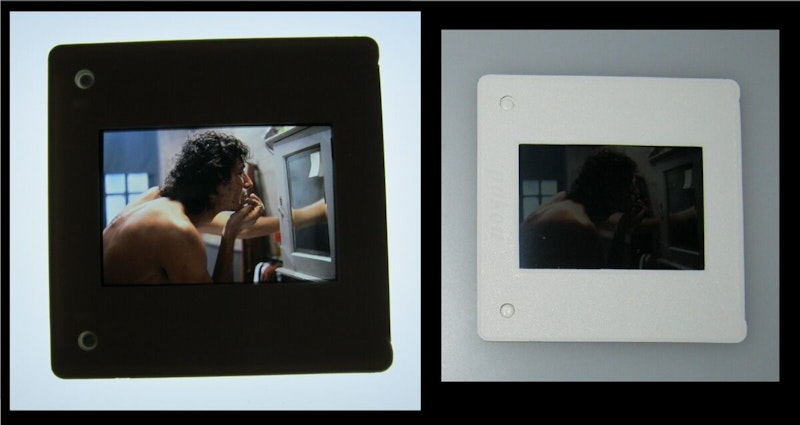On the press tour for The Shrouds, David Cronenberg said that he had “no nostalgia for film at all.” This was in part a response to Quentin Tarantino asking Cronenberg for a 35mm print of The Shrouds to play at the New Beverly, which Cronenberg claimed the presentation of would be an “indignity” to the film he made. These are bold, contra-popular opinions in the current cinema landscape, but they’re irrefutable to a degree.
Cronenberg’s right when he says that showing his film on film would be different than exhibiting the film he made. Every instance of the 35mm print running through the projector would inevitably lead to more tears, scratches, and color-warping. People often harp on the preservation qualities of physical, photochemical film, but it’s no doubt also a medium that degrades with every usage. It would be funny then for Cronenberg to deem it appropriate to show his film so concerned with the decay of the human body in a format that itself can only decay.
But that’s just the superficial; the common aesthetic argument between film and digital. What’s often overlooked is that digital itself opens the pathways to different forms of production. Ever since the advent of video villages and live monitoring of images captured by cameras, the guesswork of film—with its mirrored glimpses and rushes—was gone. A movie would never again have to be made like Godard’s Contempt, where DP Raoul Coutard had to measure by hand the focus of every shot because the Franscope anamorphic format they shot on didn’t have proper ocularly accurate eyepieces. This doesn’t matter with the plug in of an HDMI.
The allowance of imprecisions—with digital’s ability to reasonably zoom into ultra-high definition images or add stabilizing effects—perhaps enables filmmakers to be lazy, especially younger ones learning the ropes. There’s now an endemic “fix it in post” mentality, adding a lot of finicky work to the backend of projects rather than creating the circumstances for the film in the first place. However, focusing on bad habits also ignores new possibilities, which by-and-large is what older directors are actually talking about when they talk about digital.
Take, for instance, David Lynch’s insistence on never going back to film. Ever since his last theatrical work in 2006, Inland Empire, the Great American Filmmaker was ardently against returning to film, despite any of its pictorial beauty or textural qualities. Partially, this is because the Mini-DV look of Inland Empire harkened back to the dirty and ambiguous look of many poorly-kept silent films. Also, it’d be safe to say that Lynch valued digital because of its workflow: he could keep the camera rolling without worrying about mags running out, or lift the lightweight recording device in one hand instead of needing a highly-skilled technician to do it for him. Lynch’s approach to digital, in this sense, is purely practical. For Cronenberg, however, it’s ideological.
Cronenberg’s always been something of a futurist, obsessing over the latest technology or highlighting the emerging environments of postmodern lives. Digital cinema’s the perfect pair for him: not the magic trick of light staining itself on plastics, but instead diodes saying their zeroes and ones over and over, enough times to recreate the scene that was once before them. Digital cinema isn’t an oculus of the past, but a rendering, not unlike the titular shrouds in his latest film, which scan and create 3D images of loved ones as they decay. Digital, to Cronenberg, isn’t a reflection, but an act of creation in itself.

